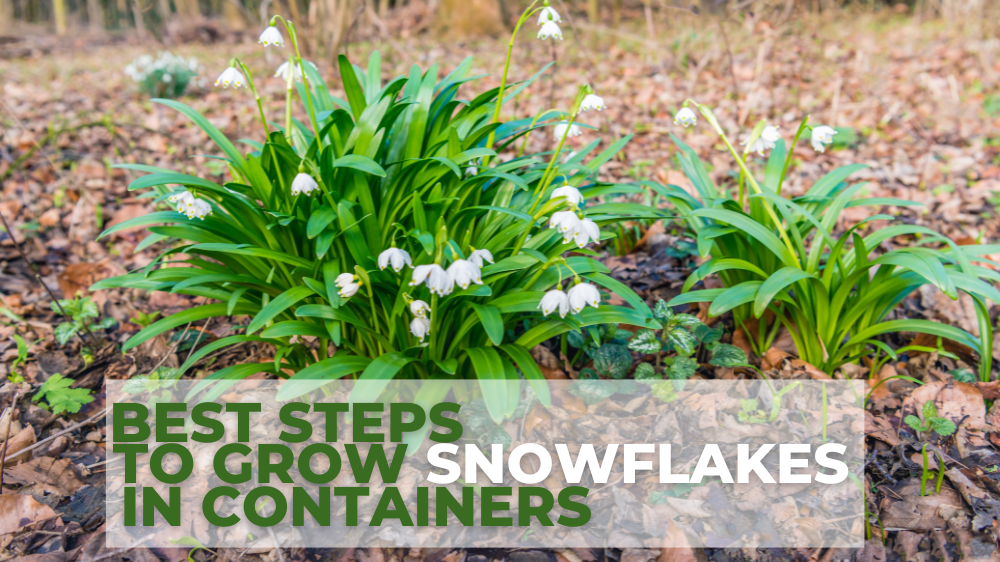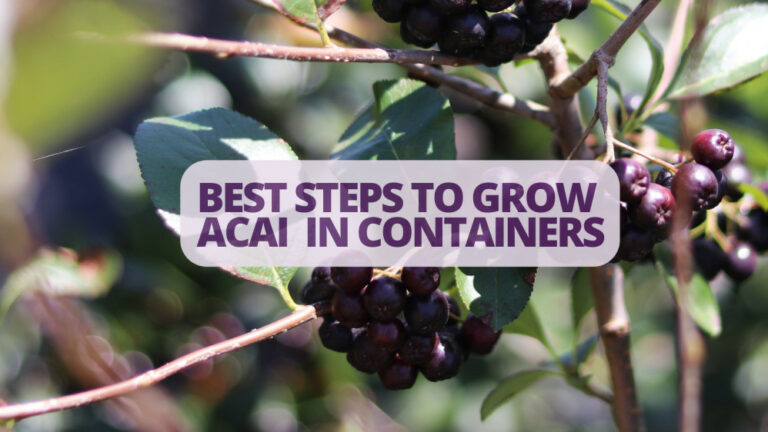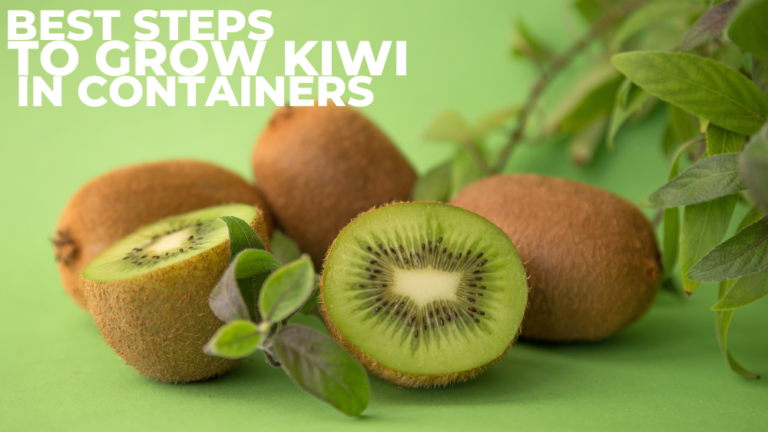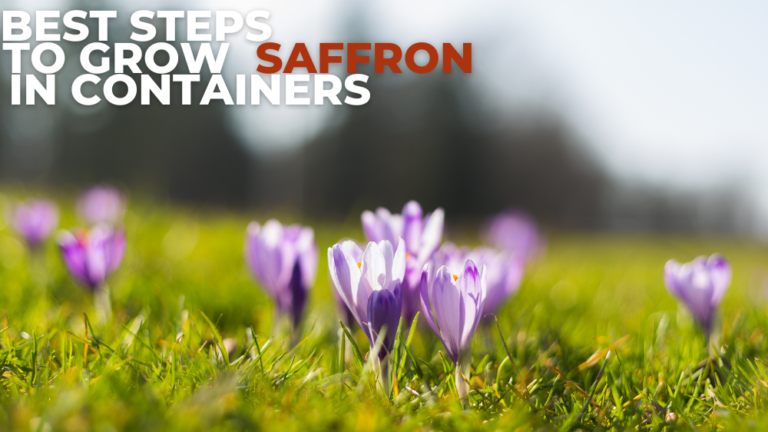Best Steps To Grow Snowflakes In Containers
Best Steps To Grow Snowflakes In Containers
Leucojum, commonly called snowflakes, are well-known for hanging bell-shaped flowers.
They need a lot of moisture, so put them in full sun or semi-shade in a location that doesn't get too dry in the summer.
In a small vase, their blooms look extremely lovely. Don't be afraid to cut the flowers; it won't harm the plant.
Snowflake Leucojum bulbs are simple and rewarding to grow in containers. Let's find out more about snowflake bulb cultivation.
History & Origin Of Snowflakes
Leucojum, a tiny genus of flowering plants in the amaryllis family is the name of the snowflake (Amaryllidaceae).
Many kinds are grown as garden flowers, including spring snowflakes (Leucojum vernum) and summer snowflakes (L. aestivum).
The plants typically emerge from bulbs in the early spring and are closely linked to snowdrops (genus Galanthus).
Perennial herbs called snowflakes have linear leaves at the base. The plants produce drooping bell-shaped blooms with six white tepals (often stained with green or yellow at the apex), undifferentiated petals and sepals.
It looks like a dried capsule. The plants are easy to establish in many locations as native species and can be multiplied by dividing the bulbs following the summer leaf-out period.
In blossom, Leucojum vernum stands 12-35 cm (4.7-13.8 in) tall. Its leaves are 5–25 mm broad and 10–25 cm (3.9–9.8 in) long and typically extend to a level below the blooms.
They grow simultaneously as the flowers and continue to lengthen throughout flowering. The flowering stem (scape) features two skinny wings and a little central cavity.
The springtime blooms known as pendants are often solitary but sporadically occur in the umbels of two.
The six white tepals of the flowers each have a greenish or yellowish mark at the base. Tepals measure 15–25 mm in length. The 7 mm-long white seeds are translucent.
In its native habitat, Leucojum vernum can be found in Austria, Belgium, the Czech Republic, Slovakia, Germany, Hungary, Poland, Switzerland, France, Italy, Romania, former Yugoslavia, and Ukraine.
It is also native to portions of southern and western Europe and Georgia and Florida in the United States.
It has naturalized in other regions of Europe, including Great Britain, the Netherlands, and several areas of Scandinavia.
It can be found up to 1600 meters above sea level in wet, shaded settings like woodlands.
Types Of Snowflakes
Because they require very little upkeep, gardeners frequently favour bulbous perennials. Plants that sprout from bulbs are typically incredibly hardy, spread quickly, and are consistent when blooming in the spring or summer!
Leucojum plants include snowflakes, snowbells, dewdrops, and St. Agnes flowers.
They may flourish in temperate climates worldwide and give your landscape a very endearing, fable-like feel. You should know about the best varieties to grow snowflakes in containers perfectly.
1. Spring Snowflakes (Leucojum Vernum)
One of the more well-known leucojum species is Leucojum vernum, native to central and southern Europe but has spread worldwide as a cultivated decorative plant variety.
The spring snowflake earns its name because it blooms in the early spring and lasts all summer.
L. vernum is a bulbous herbaceous perennial that may be recognized by its clusters of pendant-shaped white flowers with green embellishments on the tips of their tepals. The stems are only 4 to 8 inches long.
2. Summer Snowflakes (Leucojum Aestivum)
Another well-known garden plant known as the Loddon lily is Leucojum aestivum. The eastern United States, Australia, New South Wales, and Nova Scotia are now home to this European native species.
The summer snowflake earns its name because it blooms in the late spring or early summer. This bulbous perennial height ranges from 14 to 24 inches, producing distinctive pendant-shaped white blooms with green tips.
3. Gravetye Giant (Leucojum Aestivum Cultivar)
Leucojum aestivum cultivar, known as the gravetye giant, is said to be a more attractive and hardy variation of its parent plant.
It blooms in the late spring and goes dormant in the summer. It contains 4–8 pendant-shaped white flowers.
This type is renowned for its robust flowering stems, long, graceful grass-like green leaves, and blooms that are reported to have a faint chocolate scent.
Uses Of Snowflakes
The majority of a snowflake's plant parts are pretty palatable and nourishing. Young shoots, roots, and leaves are typically boiled or added to curries and served as potherbs.
Its flexible stems, which can relieve headaches, are more pleasant than its leaves. Even their fleeting flower buds and fruits are safe to eat if they are boiled first.
Fish and other water creatures may occasionally nibble on the vegetative components of snowflakes.
They might also try to eat fruits or seeds that drop into the water or sink to the bottom of the pond.
It is safe to add the plant to your decorative fish pond because none of its parts contain any hazardous substances.
The plant regenerates quickly enough to tolerate light grazing, but it should be planted in baskets or pots to provide some protection for the roots.
Spring Snowflake has demonstrated multiple advantages for the skin. Minimizing and avoiding the development of fine lines and wrinkles contributes to smoother skin.
Similar to how a flower stays dormant, the bulb extract works while you sleep to make you feel refreshed and peaceful when you wake up.
The antioxidant qualities of spring snowflakes also shield the skin from free radical damage.
Even though Leucojum aestivum flowers in the spring and is dormant in the summer, it is frequently referred to as Summer Snowflake. You can get chocolate-scented snowflake flowers. Please, yes!
Leucojum plants include snowflakes, snowbells, dewdrops, and St. Agnes flowers. They may flourish in temperate climates worldwide and give your landscape a very endearing, fable-like feel.
The snowflake plant will consistently fill any garden space with fragrant blossoms, whether you grow it in a container, a pot, as a border plant, as a ground cover plant, in hanging baskets, occasionally indoors, or in a rock garden.
Are The Water Snowflakes Invasive Or Toxic?
Despite being non-toxic, snowflakes can become invasive in moderate climates and areas with standing water.
Its rapid spread and aggressive growth propensity have made it an invasive plant in some US states, including Hawaii, Texas, and Florida.
N. indica is well-known for growing as a weed in several Asian rice paddy systems. Its seeds can survive for a few years and are easily transported by water and live vectors (such as people, waterfowl, and animals).
Herbicides have been evaluated for their effectiveness in controlling plant growth in regions where snowflake populations have significantly spread.
The floating leaves of this plant can accumulate into mats and block out sunlight when populations are unchecked or constrained.
Low oxygen levels and decreased water flow are the results of this. As a result, trapped floating debris can encourage the spread of bacteria and suffocate other aquatic vegetation.
The floating mats can sometimes make it difficult to engage in water sports, affecting summer tourism and boating businesses.
Grow Snowflakes In Containers
Various bulbs should be planted “in the green” in March. This means that rather than planting dormant bulbs in the fall, specialized nurseries remove bulbs that have typically flowered while still having their green leaves attached, ready for immediate planting.
This technique is best for growing plants with small bulbs prone to drying out, such as snowdrops, winter aconites, bluebells, and snowflakes.
While snowflakes and snowdrops both thrive in wooded settings, snowflakes flower later and establish to form imposing clusters.
Despite its name, summer snowflakes (Leucojum aestivum) bloom a few weeks after spring snowflakes in mid-to-late spring (Leucojum vernum). Depending on your plant, your snowflakes may bloom in their first year.
Growing Habits Of Snowflakes
The roots of snowflake plants begin deep within the earth from underground bulbs. A bulb is a rounded root system that serves as a reservoir for plants' nutrients and moisture to survive in adverse conditions.
Each snowflake bulb will produce hollow stalks or scapes, as they are more commonly known.
The flowering stems from which those delicate flowers emerge are known as scapes. Additionally, a bulb also produces long leaves.
Choose The Right Container
Plants grown in plastic containers have the advantages of being strong, lightweight, flexible, and durable.
Plastic pots and containers are good options for plants that prefer wetness or don't water our plants as frequently as we should.
Only use metal containers in shaded areas to avoid heat and eliminate glare, which can harm plants.
Or, to protect the soil and roots from the hot metal, coat the inside of the metal pots with bubble wrap.
Soil To Grow Snowflake In Containers
In the natural, snowflake plants appear to be able to thrive in a variety of settings, but there are several features that their soil type can have to make them as content as possible!
When these plants grow in organically rich, well-draining soil, they appear to be at their best. Fortunately, these things can be accomplished with just one easy step.
Compost! Not only will adding compost to the soil mix increase the soil's nutrient content, but it will also improve the soil's drainage.
Planting
Snowflakes prefer moist, nutrient-rich, humus-rich soil with a pH that is just slightly acidic in the spring.
Additionally, spring snowflakes prefer a sunny to semi-shaded environment, depending on the species. In the wild, they are most frequently found in mixed deciduous forests.
Shop-bought spring snowflake bulbs usually are intended for planting in the fall (September to November). Plant the bulbs in the ground 15 to 20 cm deep. The bulbs are shielded from frosts at this depth.
Bulbs should be spaced 10 to 20 cm apart. You can plant up to 100 bulbs per square metre to spread the snowflakes over a large area.
We advise spreading them out widely because snowflakes often grow the best in springtime.
Cover the area with mulch to keep the soil surrounding the bulbs moist and humus-rich.
Before planting Leucojum bulbs, put some mature compost or soil improver into any nutrient-deficient garden soil.
Watering Requirements
A gardener must provide the appropriate wet maintenance for your snowflake plant. These plants prefer continuous rainfall, and prolonged periods of drought will harm how well they perform.
They won't require watering as long as there are at least 2 inches of precipitation per week, but if there isn't, you'll need to deeply water the plant to keep the soil moist.
Sunlight Requirements
When it comes to sun exposure, snowflake plants are not particularly fussy. When they grow in the wild, they migrate towards more shady regions, although they can also tolerate bright sunshine.
However, if you have a chance to reside in an area with sweltering summer temperatures, your plant must receive at least some midday shade.
Temperature
Snowflake plants' ability to withstand cold and hot climates is another reason gardeners adore these dependable species. They can thrive in the USDA's growth zones 3 through 9.
Fertilizer
Fertile soil is what snowflake plants prefer to thrive on. There are two ways to go about doing this.
You may add some compost to the soil mixture or feed your plant a fertilizer explicitly designed for bulb plants at the start of the growing season.
Pruning
After the blooming and flowering season, you'll need to do a little pruning on your snowflake plant.
Before the plant's flowering season in late spring or early summer, prune the plant severely when the foliage dies back.
Propagation
The last part of your snowflake plant education involves growing a unique specimen. All you need to do is locate some leucojum bulbs and bury them underground.
- Purchase leucojum bulbs from friends, nearby nurseries or garden centers, or even online! Before the season's first frost, wait until mid-autumn to plant the bulbs. Ensure that you complete this before the ground freezes.
- In this manner, the tiny bulbs will nestle up and become comfortable before going dormant throughout the winter. They will be prepared entirely by spring if they do this!
- Select a location on your property with rich soil and somewhat shaded.
- Create holes between 6 and 10 inches apart and 3 to 4 inches deep. While planting them too widely apart may give the impression that they are overly spread out, these little bulbs need ample room to breathe.
- Fill in the holes and thoroughly water.
Winter Care
Snowflake must be taken indoors or maintained annually because it is not a frost-tolerant plant (particularly if you live outside USDA zones 8–11).
Transfer your potted plant to an indoor tank or basin when the temperature falls below 7°C (45°F). This must be placed in a warm greenhouse region or a frost-free room.
Before bringing it indoors, you can decide to remove some of its foliage. The plant can be moved outside after the weather warms up and the last of the winter's frosts has thawed.
Once new shoots appear, place the pot in a shallow pond region and gradually move it deeper.
Spring Care
The spring snowflake usually doesn't bloom for one to two years after planting the bulbs. They don't require fertilizer or watering in the winter.
Make sure the soil is sufficiently moist when they begin to grow in the spring. Natural rainfall often suffices.
However, spring snowflakes are content to occasionally receive a little extra water if there is a severe drought.
Apply fertilizer every few years when the spring snowflakes appear to give them the necessary nutrients. A lack of nutrients frequently causes reduced flowering and the spread of spring snowflakes.
A complete fertilizer, like our Plantura All Purpose Plant Food, is ideal because it contains all the necessary nutrients in a balanced ratio for the spring snowflake. Compost can also be used as an alternative to providing the plant with nutrients.
Pests & Diseases Of Snowflakes
Bird netting should be placed over the ground where your bulbs are planted to protect them from being dug up. Deer repellant should be used if you want to keep deer away.
Grow your snowflake bulbs in pots and containers out of the deer's reach if the first option does not work.
Gray mould, slugs, snails, aphids, nematodes, and bulb rot are the most prevalent diseases and pests that affect snowflakes.
By applying a fungicide and an insecticide spray in the early spring when green growth starts to sprout, you can aid in preventing these illnesses and dangerous insects.
Conclusion
All snowflake species are simple to grow and simple to naturalize. Because damp woodlands are their natural habitat, pick a place with those features.
The best appearance is achieved by mass planting or drift planting in woodlands.
After a long Winter, the first hint of colour in the garden comes from spring snowflakes, also a good source of early-season pollen for bees.
Feel free to comment here if you need help growing snowflakes in containers.
I trust you enjoyed this article on the Best Steps To Grow Snowflakes In Containers. Please stay tuned for more blog posts to come shortly. Take care!
JeannetteZ
>>>Please click here to read my all-inclusive article about Container Gardening<<<
>>>Are you interested in homegrown herbs and medicine? Please click here to find out more about it!<<<
Your Opinion Is Important To Me
Thoughts? Ideas? Questions? I would love to hear from you. Please leave me your questions, experience, and remarks about this article on the Best Steps To Grow Snowflakes In Containers in the comments section below. You can also reach me by email at Jeannette@Close-To-Nature.org.
Disclosure
This post may contain affiliate links. As an Amazon Associate and other affiliate programs, I earn from qualifying purchases at no extra cost to you. Read my full affiliate disclosure.
You might also enjoy these blog posts:
Best Steps To Grow Hemp In Containers
Best Steps To Grow Globe Thistles In Containers
Best Steps To Grow Saffron In Containers
Best Steps To Grow Love-Lies-Bleeding In Containers
Best Steps To Grow Cacao In Containers





















